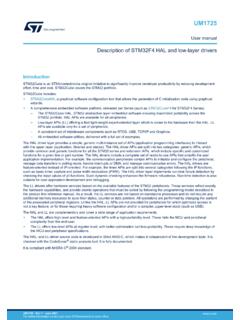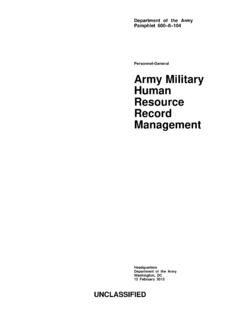Transcription of SECTION 2: INSULATION MATERIALS AND PROPERTIES
1 SECTION 2 INSULATION MATERIALS AND PROPERTIES MP-0 SECTION 2: INSULATION MATERIALS AND PROPERTIES DEFINITION OF INSULATION 1 generic TYPES AND FORMS OF INSULATION 1 PROPERTIES OF INSULATION 2 MAJOR INSULATION MATERIALS 4 PROTECTIVE COVERINGS AND FINISHES 5 PROPERTIES OF PROTECTIVE COVERINGS 6 ACCESSORIES 7 SUMMARY - INSULATION MATERIALS AND APPLICATION WITHIN THE GENERAL TEMPERATURE RANGES 8 INSULATION AND JACKET material TABLES 10 SECTION 2 INSULATION MATERIALS AND PROPERTIES MP-1 SECTION 2 INSULATION MATERIALS AND PROPERTIES DEFINITION OF INSULATION Insulations are defined as those MATERIALS or combinations of MATERIALS which retard the flow of heat
2 Energy by performing one or more of the following functions: 1. Conserve energy by reducing heat loss or gain. 2. Control surface temperatures for personnel protection and comfort. 3. Facilitate temperature control of process. 4. Prevent vapour flow and water condensation on cold surfaces. 5. Increase operating efficiency of heating/ventilating/cooling, plumbing, steam, process and power systems found in commercial and industrial installations. 6. Prevent or reduce damage to equipment from exposure to fire or corrosive atmospheres. 7. Assist mechanical systems in meeting criteria in food and cosmetic plants. 8. Reduce emissions of pollutants to the atmosphere. The temperature range within which the term "thermal INSULATION " will apply, is from -75 C to 815 C.
3 All applications below -75 C are termed "cryogenic", and those above 815 C are termed "refractory". Thermal INSULATION is further divided into three general application temperature ranges as follows: A. LOW TEMPERATURE THERMAL INSULATION 1. From15 C through 1 C - Cold or chilled water. 2. 0 C through -40 C - Refrigeration or glycol. 3. -41 C through -75 C - Refrigeration or brine. 4. -76 C through -273 C (absolute zero) - Cryogenic. (Not addressed in this manual). B. INTERMEDIATE TEMPERATURE THERMAL INSULATION 1. 16 C through 100 C - Hot water and steam condensate. 2. 101 C through 315 C - Steam, high temperature hot water. C. HIGH TEMPERATURE THERMAL INSULATION 1. 316 C through 815 C - Turbines, breechings, stacks, exhausts, incinerators, boilers.
4 generic TYPES AND FORMS OF INSULATION SECTION 2 INSULATION MATERIALS AND PROPERTIES MP-2 Insulations will be discussed in this manual according to their generic types and forms. The type indicates composition ( glass, plastic) and internal structure ( cellular, fibrous). The form implies overall shape or application ( board, blanket, pipe covering). TYPES 1. Fibrous INSULATION - composed of small diameter fibers which finely divide the air space. The fibers may be perpendicular or parallel to the surface being insulated, and they may or may not be bonded together. Silica, rock wool, slag wool and alumina silica fibers are used. The most widely used insulations of this type are glass fiber and mineral wool.
5 Glass fiber and mineral wool products usually have their fibers bonded together with organic binders that supply the limited structural integrity of the products. 2. Cellular INSULATION - composed of small individual cells separated from each other. The cellular material may be glass or foamed plastic such as polystyrene (closed cell), polyisocyanurate and elastomeric. 3. Granular INSULATION - composed of small nodules which may contain voids or hollow spaces. It is not considered a true cellular material since gas can be transferred between the individual spaces. This type may be produced as a loose or pourable material , or combined with a binder and fibers or undergo a chemical reaction to make a rigid INSULATION . Examples of these insulations are calcium silicate, expanded vermiculite, perlite, cellulose, diatomaceous earth and expanded polystyrene.
6 FORMS Insulations are produced in a variety of forms suitable for specific functions and applications. The combined form and type of INSULATION determine its proper method of installation. The forms most widely used are: 1. Rigid boards, blocks, sheets, and pre-formed shapes such as pipe INSULATION , curved segments, lagging etc. Cellular, granular, and fibrous insulations are produced in these forms. 2. Flexible sheets and pre-formed shapes. Cellular and fibrous insulations are produced in these forms. 3. Flexible blankets. Fibrous insulations are produced in flexible blankets. 4. Cements (insulating and finishing). Produced from fibrous and granular insulations and cement, they may be of the hydraulic setting or air drying type. 5. Foams.
7 Poured or froth foam used to fill irregular areas and voids. Spray used for flat surfaces. PROPERTIES OF INSULATION Not all PROPERTIES are significant for all MATERIALS or applications. Therefore, many are not included in manufacturers' published literature or in the Table of PROPERTIES which follows this SECTION . In some applications, however, omitted PROPERTIES may assume extreme importance ( when insulations must be compatible with chemically corrosive atmospheres.) If the property is significant for an application and the measure of that property cannot be found in manufacturers' literature, effort should be made to obtain the information directly from the manufacturer, testing laboratory or INSULATION contractors association.
8 The following PROPERTIES are referenced only according to their significance in meeting design criteria of specific applications. More detailed definitions of the PROPERTIES themselves can be found in the Glossary. SECTION 2 INSULATION MATERIALS AND PROPERTIES MP-3 THERMAL PROPERTIES OF INSULATION Thermal PROPERTIES are the primary consideration in choosing insulations. Refer to the following Glossary for definitions. a. Temperature limits: Upper and lower temperatures within which the material must retain all its PROPERTIES . b. Thermal conductance "C": The time rate of steady state heat flow through a unit area of a material or construction induced by a unit temperature difference between the body surfaces.
9 C. Thermal conductivity "K": The time rate of steady state heat flow through a unit area of a homogeneous material induced by a unit temperature gradient in a direction perpendicular to that unit area. d. Emissivity "E": The emissivity of a material (usually written or e) is the relative ability of its surface to emit energy by radiation. It is the ratio of energy radiated by a particular material to energy radiated by a black body at the same temperature. e. Thermal resistance "R": Resistance of a material to the flow of heat. f. Thermal transmittance "U": The overall conductance of heat flow through an "assembly". MECHANICAL AND CHEMICAL PROPERTIES OF INSULATION PROPERTIES other than thermal must be considered when choosing MATERIALS for specific applications.
10 Among them are: a. Alkalinity (pH) or acidity: Significant when moisture is present. Also INSULATION must not contribute to corrosion of the system. See SECTION 3. b. Appearance: Important in exposed areas and for coding purposes. c. Breaking load: In some installations the INSULATION material must "bridge" over a discontinuity in its support. This factor is however most significant as a measure of resistance to abuse during handling. d. Capillarity: Must be considered when material may be in contact with liquids. e. Chemical reaction: Potential fire hazards exist in areas where flammable chemicals are present. Corrosion resistance must also be considered. f. Chemical resistance: Significant when the atmosphere is salt or chemical laden and when pipe content leaks.












